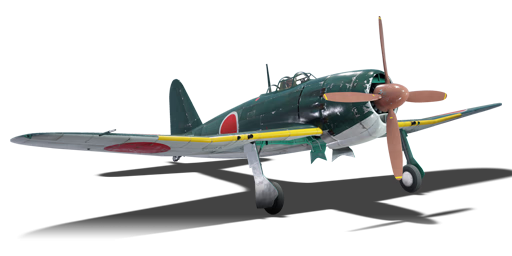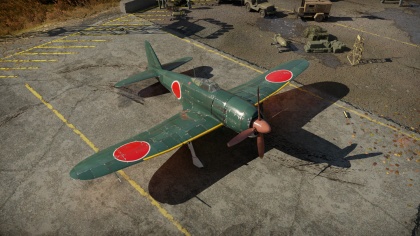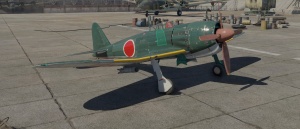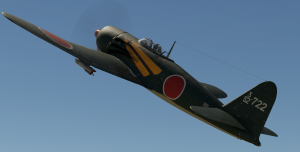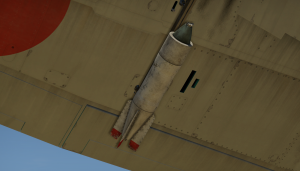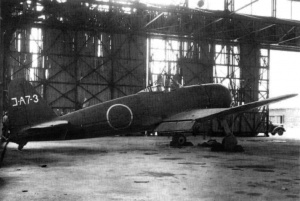Difference between revisions of "A7M2"
(→Usage in battles: Edits) |
|||
| Line 1: | Line 1: | ||
| − | {{Specs-Card|code=a7m2}} | + | {{Specs-Card |
| + | |code=a7m2 | ||
| + | |images={{Specs-Card-Image|}} | ||
| + | }} | ||
{{About | {{About | ||
| about = Japanese fighter '''{{PAGENAME}}''' | | about = Japanese fighter '''{{PAGENAME}}''' | ||
| Line 14: | Line 17: | ||
== General info == | == General info == | ||
=== Flight performance === | === Flight performance === | ||
| + | {{Specs-Avia-Flight}} | ||
<!-- ''Describe how the aircraft behaves in the air. Speed, manoeuvrability, acceleration and allowable loads - these are the most important characteristics of the vehicle.'' --> | <!-- ''Describe how the aircraft behaves in the air. Speed, manoeuvrability, acceleration and allowable loads - these are the most important characteristics of the vehicle.'' --> | ||
[[File:A7M2onground.png|thumb|The A7M2 on the ground, sporting a camouflage from the Market]] | [[File:A7M2onground.png|thumb|The A7M2 on the ground, sporting a camouflage from the Market]] | ||
| Line 74: | Line 78: | ||
=== Survivability and armour === | === Survivability and armour === | ||
| + | {{Specs-Avia-Armour}} | ||
<!-- ''Examine the survivability of the aircraft. Note how vulnerable the structure is and how secure the pilot is, whether the fuel tanks are armoured, etc. Describe the armour, if there is any, and also mention the vulnerability of other critical aircraft systems.'' --> | <!-- ''Examine the survivability of the aircraft. Note how vulnerable the structure is and how secure the pilot is, whether the fuel tanks are armoured, etc. Describe the armour, if there is any, and also mention the vulnerability of other critical aircraft systems.'' --> | ||
[[File:A7M2 armour.jpg|thumb|The armour found on the A7M2]] | [[File:A7M2 armour.jpg|thumb|The armour found on the A7M2]] | ||
| Line 82: | Line 87: | ||
While being slightly more durable than its older brother, the Reppu is still very vulnerable to any kind of battle damage. Anything with greater than .50 calibre weapons will be able to take off a wing or worse. The wingspan has also increased significantly to keep the manoeuvrability of the Zero while supporting increased weight added from the guns, engine and other updates. A downside is that this makes the wings easier to hit. However, The manoeuvrability of the Reppu allows this aircraft to avoid most damage if you can keep turning. | While being slightly more durable than its older brother, the Reppu is still very vulnerable to any kind of battle damage. Anything with greater than .50 calibre weapons will be able to take off a wing or worse. The wingspan has also increased significantly to keep the manoeuvrability of the Zero while supporting increased weight added from the guns, engine and other updates. A downside is that this makes the wings easier to hit. However, The manoeuvrability of the Reppu allows this aircraft to avoid most damage if you can keep turning. | ||
| + | |||
| + | === Modifications and economy === | ||
| + | {{Specs-Economy}} | ||
== Armaments == | == Armaments == | ||
| + | {{Specs-Avia-Armaments}} | ||
=== Offensive armament === | === Offensive armament === | ||
| + | {{Specs-Avia-Offensive}} | ||
<!-- ''Describe the offensive armament of the aircraft, if any. Describe how effective the cannons and machine guns are in a battle, and also what belts or drums are better to use. If there is no offensive weaponry, delete this subsection.'' --> | <!-- ''Describe the offensive armament of the aircraft, if any. Describe how effective the cannons and machine guns are in a battle, and also what belts or drums are better to use. If there is no offensive weaponry, delete this subsection.'' --> | ||
[[File:A7M2RocketShot.png|thumb|A7M2 firing its rockets. Unlike the [[A7M1 (NK9H)|A7M1]], it can carry rockets]] | [[File:A7M2RocketShot.png|thumb|A7M2 firing its rockets. Unlike the [[A7M1 (NK9H)|A7M1]], it can carry rockets]] | ||
| Line 95: | Line 105: | ||
=== Suspended armament === | === Suspended armament === | ||
| + | {{Specs-Avia-Suspended}} | ||
<!-- ''Describe the aircraft's suspended armament: additional cannons under the wings, bombs, rockets and torpedoes. This section is especially important for bombers and attackers. If there is no suspended weaponry remove this subsection.'' --> | <!-- ''Describe the aircraft's suspended armament: additional cannons under the wings, bombs, rockets and torpedoes. This section is especially important for bombers and attackers. If there is no suspended weaponry remove this subsection.'' --> | ||
{{main|Navy Type 97 Number 6 (60 kg)|Type 3 No.1 Mod.28 Mk.1|Type 3 No.6 Mod.27 Mk.1|Type 5 No.1 Mod.9|Type 5 No.6 Mod.9}} | {{main|Navy Type 97 Number 6 (60 kg)|Type 3 No.1 Mod.28 Mk.1|Type 3 No.6 Mod.27 Mk.1|Type 5 No.1 Mod.9|Type 5 No.6 Mod.9}} | ||
Revision as of 11:42, 24 December 2020
Contents
| This page is about the Japanese fighter A7M2. For premium version, see A7M1 (NK9H). |
Description
The A7M2 Reppu is a rank IV Japanese fighter
with a battle rating of 5.0 (AB), 5.3 (RB), and 4.7 (SB). It was introduced in Update 1.55 "Royal Armour".
General info
Flight performance
The A7M Reppu was designed to be an improved version of the famed A6M Zero fighter, and as such, retains some of its legendary older brother's characteristics. The Reppu is an overall smooth operator at most altitudes thanks to its decent acceleration, vastly improved speed and decent manoeuvrability. Less manoeverable than the Zero, it can at certain times really struggle in dogfights, the rudder has a want to fight you at every turn requiring forceful control and slight damage to the airframe negates most of its ability to dogfight anything but the slowest turners effectively. The most noteworthy change is the replacement of the underpowered Nakajima Sakae Radial engine with a significantly more powerful Mitsubishi Ha-43 Radial. This new engine propels the Reppu to higher speeds previously unobtainable by the Zero and turns this aircraft from a nuisance to a universally feared opponent.
| Characteristics | Max Speed (km/h at 5,660 m) |
Max altitude (metres) |
Turn time (seconds) |
Rate of climb (metres/second) |
Take-off run (metres) | |||
|---|---|---|---|---|---|---|---|---|
| AB | RB | AB | RB | AB | RB | |||
| Stock | 608 | 589 | 11000 | 19.3 | 20.2 | 15.1 | 15.1 | 250 |
| Upgraded | 654 | 630 | 18.8 | 19.0 | 22.8 | 18.5 | ||
Details
| Features | ||||
|---|---|---|---|---|
| Combat flaps | Take-off flaps | Landing flaps | Air brakes | Arrestor gear |
| ✓ | ✓ | ✓ | X | ✓ |
| Limits | ||||||
|---|---|---|---|---|---|---|
| Wings (km/h) | Gear (km/h) | Flaps (km/h) | Max Static G | |||
| Combat | Take-off | Landing | + | - | ||
| 826 | 310 | 510 | 510 | 280 | ~12 | ~9 |
| Optimal velocities (km/h) | |||
|---|---|---|---|
| Ailerons | Rudder | Elevators | Radiator |
| < 400 | < 380 | < 400 | > 324 |
Survivability and armour
- 70 mm bulletproof glass in front of the pilot
- 13 mm steel plate behind the pilot seat
- Self-sealing fuel tanks
While being slightly more durable than its older brother, the Reppu is still very vulnerable to any kind of battle damage. Anything with greater than .50 calibre weapons will be able to take off a wing or worse. The wingspan has also increased significantly to keep the manoeuvrability of the Zero while supporting increased weight added from the guns, engine and other updates. A downside is that this makes the wings easier to hit. However, The manoeuvrability of the Reppu allows this aircraft to avoid most damage if you can keep turning.
Modifications and economy
Armaments
Offensive armament
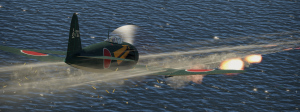
The A7M2 is armed with:
- 2 x 20 mm Type 99 Model 2 cannons, wing-mounted (200 rpg = 400 total)
- 2 x 13.2 mm Type 3 machine guns, wing-mounted (300 rpg = 600 total)
Suspended armament
The A7M2 can be outfitted with the following ordnance:
- Without load
- 2 x 60 kg Navy Type 97 Number 6 bombs (120 kg total)
- 2 x Type 3 No.1 Mod.28 Mk.1 rockets
- 2 x Type 5 No.1 Mod.9 rockets
- 2 x Type 3 No.6 Mod.27 Mk.1 rockets
- 2 x Type 5 No.6 Mod.9 rockets
Usage in battles
The A7M2 Reppu that takes the best of the A6M and does it better also translates it in aerial combat. With its higher engine output, very similar manoeuvrability and higher rip-speeds, it can engage in all playstyles; whether the situation calls for it the A7M can either turn fight, Boom-&-Zoom, energy fight and others. Yet it is sometimes tricky to maintaining energy fights with enemies like the F6F-5, P-51, etc.
Tactics
- Ground pounding
While Japan isn't exactly a nation that has a lot of ground pounding capacity with the mainstay theatre being the Pacific, the A7M2 is the lowest battle rating Japanese plane that boasts heavy rockets that can destroy the heaviest of ground targets. Together with the fact they are fired separately, 2 kills are easy with proper aiming.
Along with the rockets, it boasts 13.2 mm & 20 mm guns on a very manoeuvrable platform making it very easy to just stay close to ground level, re-adjusting on target and diving in on vehicle roofs and blasting engines & turret crew.
- Low altitude fighting
This is where the A7M2 shines and players familiar with the A6M will feel right at home. Newer players will become familiar with its playstyle quite easily due its better performance and more forgiving yet punchier gun-choice with plenty of ammo to spare.
Only couple of planes like Spitfires can be a challenging opponent at low altitudes, mainly because most planes will lose energy when fighting with the A7M2 at low altitudes when the A7M2 is able to outturn and be on their tail in couple seconds. The 13 mm and 20 mm armaments combined are very deadly and will tear down a plane in a good placed burst. Aim for center of mass when turn fighting, and tail when tailing, especially the elevators.
- High altitude fighting
Turn fighting at high altitude is rather difficult since, the higher you go, the less air density there is. This means there will be less air to lift your plane when doing a hard turn compared to sea level, meaning the A7M1 will not be able to turn as fast as you do at sea level. This should be taken into consideration since most of the planes at high altitudes (4+ km) often have superchargers or turbochargers (Wyvern S4 for example) and will make an easy prey out of you, as you do not maintain the same energy nor speed they maintain.
- Bomber Interception
The drawbacks from high altitude does not stop the A7M1 from fighting in the clouds. One of the easiest targets for the A7M2 are bombers. They are big, have big wingspans and are often slow (unless they are dive bombers or strike fighters). They can be easily destroyed with the 13 mm and 20 mm armaments due to their sheer calibre and destructive ammunition. When engaging a bomber, aim for the engines or wings. With the right belts equipped, a few well placed shots will set them afire or even shred the wings.
Be careful when engaging bigger preys as they might turn into a predator if handled wrongly. Hit fast and hard, put bullets into the cockpit or make short work of their wings. Do not tail it, most bombers will shred the A7M badly and a fire is most guaranteed, which the A7M won't last long through.
Manual Engine Control
| MEC elements | ||||||
|---|---|---|---|---|---|---|
| Mixer | Pitch | Radiator | Supercharger | Turbocharger | ||
| Oil | Water | Type | ||||
| Controllable | Controllable Not auto controlled |
Controllable Not auto controlled |
Controllable Not auto controlled |
Separate | Controllable 2 gears |
Not controllable |
Modules
| Tier | Flight performance | Survivability | Weaponry | |||
|---|---|---|---|---|---|---|
| I | Fuselage repair | Radiator | Offensive 13 mm | Type 3 No.1 Mod.28 Mk.1 rockets | ||
| II | Compressor | Airframe | New 13 mm MGs | Type 5 No.1 Mod.9 rockets | 9 in (mod30) | |
| III | Wings repair | Engine | Offensive 20 mm | Type 3 No.6 Mod.27 Mk.1 rockets | ||
| IV | Engine injection | Cover | New 20 mm cannons | Type 5 No.6 Mod.9 rockets | ||
Pros and cons
Pros:
- Performance; comparable/better than the A6Ms:
- Surprisingly agile at all altitudes and most speeds
- Vastly improved speed and diving ability
- Can dogfight situationally
- Armament:
- Large ammunition pool
- Fields 13.2 mm machine guns unlike most other Japanese fighters using 7.7 mms
- Can mount unguided rockets
- Larger rockets are useful on ground targets
- All can be set with a fuse to be used as air-to-air
- Other:
- 70 mm bulletproof glass in front of the pilot
Cons:
- Significantly increased size compared to A6M
- Flimsy and large wings, easily damaged
- Roll rate extremely slow, slow turn prep
- Control stiffening begins at relatively low speeds
- 13.2 mms jam faster than other 12.7 mm counterparts.
History
As the A7M1 was a letdown for the navy, which made them want to cancel the project still allowed Mitsubishi to develop into making an A7M with an in-house engine, being the Mitsubishi Ha-43 which had more power and would be the engine to succeed to the Navy's requirements.
As so, the new A7M2 with Ha-43 had its test flight in October 1944 by no-one other than Saburo Sakai and proved more than capable with checking off most requirements by some slight underperformance of speed. As the aging A6M doesn't compare to the A7M2, the Navy cancelled the formal cancelation of the A7M project and adopted the A7M2 as their new main carrier-based fighter.
In late 1944 an earthquake strained the manufacturing of the A7M2 causing only 8 to be built. In early 1945, Allied bombings of Japans mainland lead to the destruction of the A7M plans. This ceased the whole development of the A7M2 and the plane would never see combat.
Only a single A7M2 would be built in 1945 due to allied bombings and none remain surviving WWII.
Media
- Skins
- Videos
See also
Links to the articles on the War Thunder Wiki that you think will be useful for the reader, for example:
- reference to the series of the aircraft;
- links to approximate analogues of other nations and research trees.
External links
Paste links to sources and external resources, such as:
- topic on the official game forum;
- encyclopedia page on the aircraft;
- other literature.
| Mitsubishi Company (三菱商会) | |
|---|---|
| Fighters | A5M4 · Hagiri's A5M4 |
| A6M2 mod. 11 · A6M2 · A6M3 · A6M3 mod. 22 · A6M3 mod. 22Ko · A6M5 · A6M5 Ko · A6M5 otsu · A6M5 Hei · A6M6c | |
| A7M1 (NK9H) · A7M2 | |
| J2M2 · J2M3 · J2M4 Kai · J2M5 · J2M5 (30 mm) | |
| Hydroplanes | F1M2 |
| Interceptors | Ki-83 · Ki-109 |
| Bombers | G4M1 |
| Ki-21-Ia · Ki-21-I hei · Ki-67-I Ko · Ki-67-I otsu | |
| Jet Fighters | Ki-200 |
| Captured | ▃A6M2 · ␗A6M2 |
| See also | Mitsubishi Heavy Industries, Ltd. (Post-War) |
| Japan fighters | |
|---|---|
| Navy | |
| Carrier-based fighter | |
| A5M | A5M4 · Hagiri's A5M4 |
| A6M | A6M2 mod. 11 · A6M2 · A6M3 · A6M3 mod. 22 · A6M3 mod. 22Ko · A6M5 · A6M5 Ko · A6M5 otsu · A6M5 Hei · A6M6c |
| A7He | A7He1* |
| A7M | A7M1 (NK9H) · A7M2 |
| Land-based Fighter | |
| J2M | J2M2 · J2M3 · J2M4 Kai · J2M5 · J2M5 (30 mm) |
| J6K | J6K1 |
| J7W | J7W1 |
| N1K-J | N1K1-Ja · N1K2-J · N1K2-Ja |
| Fighter seaplane | |
| N1K | N1K1 |
| A6M-N | A6M2-N |
| Army | |
| Ki-10 | Ki-10-I · Ki-10-I C · Ki-10-II · Ki-10-II C |
| Ki-27 | Ki-27 otsu · Ki-27 otsu Tachiarai |
| Ki-43 | Ki-43-I · Ki-43-II · Ki-43-III otsu |
| Ki-44 | Ki-44-I · Ki-44-I 34 · Ki-44-II otsu · Ki-44-II hei |
| Ki-61 | Ki-61-I ko · Ki-61-I otsu · Ki-61-I hei · Tada's Ki-61-I hei · Ki-61-I tei · Ki-61-II Otsu Kai |
| Ki-84 | Ki-84 ko · Ki-84 otsu · Ki-84 hei |
| Ki-87 | Ki-87 |
| Ki-94 | Ki-94-II |
| Ki-100 | Ki-100 · Ki-100-II |
| Other countries | ▅F4U-1A · ▅P-51C-11-NT · ▅Bf 109 E-7 · ▅Fw 190 A-5 |
| *Imported designation of the He 112 (A6M was in development - A7M would take A7 designation after the cancelation of the A7He) | |


